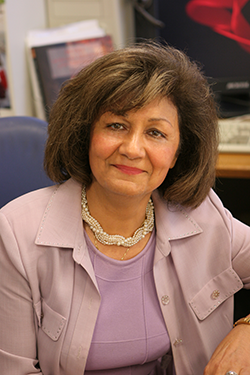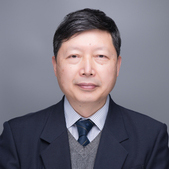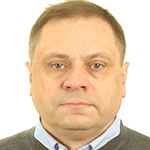Plenary Speakers

Title: Next Frontier in Quantum Semiconductor science and technology
Abstract:
Nature has stimulated human thought and invention before recorded time. Nature offer us a full assortment of Atoms in the periodic table. Different atoms emit light with different colors or energy when oscillating - from gamma rays, X-Rays, Ultraviolet (UV), visible and through invisible infrared (IR)rays down to THz. However, our eyes can see only a small part of the total electromagnetic spectrum. The colors of the rainbow, detecting and creating light of different colors requires first a profound understanding of the structure of the atom, through Quantum Mechanics, and a special type of materials called semiconductors, the heart of all modern Quantum electronics, and photonics.To both see and shine light in either of these wavelength bands requires a team of scientists to invent new models, materials and devices. This is what my lab is dedicated to exploring this frontier of the unseen by developing the science and technologies of Semiconductor Quantum devices to both detect and create light of different colors from Deep UV to THz.We can create assemblies of atoms that intercept and launch light anywhere in the entire spectrum, according to the crystal structure we design. For example, small semiconductor lasers diodes have been developed that emit at specific wavelengths needed for the telecommunication industry. This revolutionized our communication capabilities. We can now communicate with each other faster, over ever larger distances, sharing ever more information. In addition, lasers of many different wavelengths are used to sense the world around us by looking at how the light is either absorbed or reflected. This is used for air pollution monitoring and chemical/biological agent detection, etc.We are able to shine light of any color in beams that can travel to the moon and back.We can also create crystals of matter that allow us to see even the invisible light in the infrared, and ultraviolet spectrum. This expands our natural vision ability and provides a wealth of new knowledge. For instance, we can map the universe with telescopes that see these invisible colors, and we can image the human body to find cures and treat diseases. The electromagnetic spectrum is very broad, and we are still trying to fill in the wavelength gaps of the entire spectrum!!
By atomic and energy gap engineering, use of different bulk crystals, epitaxy, photolithography, and mimicking nature we can create “Artificial molecules” or Quantum Wires, “Artificial atoms” or Quantum Dots. Information technology can be revolutionized by these Artificial Atoms and Molecules.
In the future, Artificial Active materials can be produced such as a Nano Sensor, nano machines, and Smart materials (with adjustable viscosity, density, elasticity,.) Some of the other ways we can use these quantum materials is in quantum sensing. By quantum sensing we mean ways we can use quantum materials to mimic and improve on, our own human senses.
In conclusion, Since the dawn of artificial light 130 years ago, engineered materials have been the key to producing light. From incandescent bulbs to lasers to photonic quantum computers, the complexity of materials has accelerated to produce light with ever more control for ever more refined applications, bounded only by the creative power of the human mind.
This talk will describe how; The continuation of Fundamental research in Quantum Semiconductor Technologies that are excited for the generation of, or response to, the light( photons), illuminating our minds towards the next revolution of understanding ourselves and universe!
Biography:
Manijeh Razeghi received the Doctorate d’état ES Sciences Physiques from the Université de Paris, France, in 1980.
Manijeh Razeghi was the Head of the Exploratory Materials Laboratory at Thomson-CSF (France) during the 80’s where she developed and implemented modern metalorganic chemical vapor deposition (MOCVD) vapor phase epitaxy (VPE), molecular beam epitaxy (MBE), GasMBE, and MOMBE for entire compositional ranges of III-V compound semiconductors from deep UV to THZ. Developing these tools was fundamental in enabling her to achieve high purity semiconductor crystals with a consistency and reliability that was often unmatched, thereby leading to new physics phenomena in InP , GaAs, GaSb, and AlN based semiconductors and quantum structures. She realized the first InP Quantum wells and Superlattices and demonstrated the marvels of quantum mechanics in the low dimensional world.
She joined Northwestern University, Evanston, IL, as a Walter P. Murphy Professor and Director of the Center for Quantum Devices in Fall 1991, where she created the undergraduate and graduate program in solid-state engineering.
She has authored or co-authored more than 1000 papers, more than 35 book chapters, and 20 books, including the textbooks Technology of Quantum Devices (Springer Science Business Media, Inc., New York, NY U.S.A. 2010) and Fundamentals of Solid State Engineering, 4th Edition (Springer Science Business Media, Inc., New York, NY U.S.A. 2018). Two of her books, MOCVD Challenge Vol. 1 (IOP Publishing Ltd., Bristol, U.K., 1989) and MOCVD Challenge Vol. 2 (IOP Publishing Ltd., Bristol, U.K., 1995), discuss some of her pioneering work in InP-GaInAsP and GaAs-GaInAsP based systems. The MOCVD Challenge, 2nd Edition (Taylor & Francis/CRC Press, 2010) represents the combined updated version of Volumes 1 and 2. She holds many U.S. patents and has given more than 1000 invited and plenary talks. Her current research interest is in nanoscale optoelectronic quantum devices. From deep UV to Thz.
Dr. Razeghi is a Fellow of MRS, IOP, IEEE, APS, SPIE, OSA, Fellow and Life Member of Society of Women Engineers (SWE), and Fellow of the International Engineering Consortium (IEC). She received the IBM Europe Science and Technology Prize in 1987, the Achievement Award from the SWE in 1995, the R.F. Bun shah Award in 2004, IBM Faculty Award 2013, the Jan Czochralski Gold Medal in 2016, the 2018 Benjamin Franklin Medal in Electrical Engineering, LSA 10th Anniversary Outstanding Contribution Award, and many best paper awards. She is an elected life-Fellow of SWE, IEEE, and MRS. She is honored as a member of Academy of Europe 2021.

Title: Fast and sensitive bolometric terahertz detection at room temperature through thermomechanical transduction
Abstract:
Utilizing a thermomechanical transduction scheme, we have developed an uncooled, sensitive, and fast THz bolometer by using a doubly clamped GaAs MEMS beam resonator as a sensitive thermistor. Owing to its ultra-high temperature sensitivity (the noise equivalent temperature difference of ~1 μK/√Hz), the present MEMS bolometer achieves not only a high sensitivity but also an operation bandwidth of several kHz, which is ~100 times faster than other uncooled THz thermal sensors. The MEMS bolometers are fabricated by the standard semiconductor fabrication processes and are well suited for making detector arrays for realizing THz cameras.
This work has been supported by SCOPE program of Ministry of Internal Affairs and Communications (#JP225006001), A-STEP program from Japan Science and Technology Agency, and KAKENHI B from Japan Society for the Promotion of Science.
Biography:
Kazuhiko Hirakawa received the B.E., M.E., and Ph.D. degrees in electronic engineering in 1982, 1984, and 1987, respectively, from University of Tokyo. He is currently a professor at Institute of Industrial Science, University of Tokyo. He is also serving as a director of Institute for Nano Quantum Information Electronics, University of Tokyo. He was a visiting researcher at Princeton University for 1991-1993 and a visiting professor at Physics Department, Ecole Normale Superieure in 2006. His current research interests include terahertz dynamics of quantum nanostructures, novel terahertz detection using MEMS resonators, and cooling effect in semiconductor heterostructures. His honor includes the Japan IBM Prize in 2005, the Quantum Devices Award in 2016, and the Leo Esaki Prize in 2018.

Wei Lu
Shanghai Institute of Technical Physics of the Chinese Academy of Sciences, China
Title: Quantum Well Infrared Detectors for Space Application Prospects with Electro-Optical Joint Manipulation and Beyond
Abstract:
In the field of infrared remote sensing, the technical process involves the transmission of infrared photons, photoelectric detection, electrical signal processing, target recognition, and decision-making. A significant bottleneck from infrared detection to target recognition is the efficient enhancement of the ratio of infrared photoelectrons between targets and non-targets to improve target recognition rates. Addressing this challenge at the pixel level of photoelectric conversion has become a crucial direction in the development of infrared optoelectronic devices. Quantum well infrared photodetectors are particularly suited to this trend, especially in space-to-earth observation applications with strong background infrared radiation.
We have successfully established a quantum well infrared focal plane technology system centered on the joint regulation of light fields and electronic localized states, enabling a new breakthrough in China's space infrared remote sensing technology.
In terms of design principles, we proposed and constructed an infrared detection approach with localized state features. By leveraging new understandings of photoelectric conversion and carrier transport mechanisms, we established a new working mode for the infrared focal plane array that jointly regulates localized and extended states.
In the field of manufacturing process technology, we have successfully overcome key technical challenges in integrating focal plane array processes by utilizing the microcavity control effects based on plasmonics in the application on infrared-sensitive elements. We have produced three types of quantum well long-wave infrared focal planes—spectral, intensity, and polarization—using localized state control, which significantly enhanced the device performance.
In the application verification phase, our spectral-focal plane array technology has been successfully applied to China's remote sensing satellites in 2023. Additionally, our intensity-focal plane array has been used in new technology test satellites. Furthermore, our polarization-focal plane has been applied in unmanned aerial vehicle target recognition field experiments, improving target recognition capabilities by an order of magnitude.
Further, we explored the possibility of forming high-performance detectors based on the physical foundation of strong-field-induced non-equilibrium states. By developing methods to measure electron temperature through the amplitude of random electron motion, we found that under a high electric field of up to 5×105 V/cm, the electron temperature significantly exceeds the lattice temperature, and exhibits quasi-adiabatic transport with nearly zero net energy exchange with phonons on a nanoscale. This type of quasi-adiabatic transport property, verified in the strong electric fields formed by step-like van der Waals heterojunctions, demonstrated the potential to break the limits of carrier transport determined by the detector drift-diffusion model, transitioning photogenerated carrier transport from dissipative to quasi-adiabatic, thereby effectively enhancing photocurrent.
Biography:
Prof. Lu got his bachelor's degree from the Department of physics at Fudan University, and then got his doctoral degree from the Shanghai Institute of Technical Physics, Chinese Academy of Sciences. He worked as a postdoctoral researcher in Technische Universität Braunschweig funed by the Humboldt Research Fellowship. After that, he worked in University of Gothenburg in Sweden, the Australian National University in Australia, Humblodt University of Berlin as a visting professor.

Abstract:
The invention of maser by N. Basov and A. Prokhorov marked the beginning of a laser era. The principle of stimulated emission was brilliantly implemented in microwave radiation in molecular beams. Nowadays, solid state media are used to obtain visible and NIR laser radiation. At the same time, obtaining coherent microwave radiation has been neglected. In recent years, rapid development of molecular crystal growth technology has enabled to describe new mechanisms of maser origin for generating coherent microwave radiation in solid state. In my lecture I’m going to give the historical overview of the development of ideas in microwave and later THz radiation in solid state. I’ll speak about the unique properties of molecular crystals as if specially created for the development of coherent THz radiation. The special role in such crystals is played by time resolved behavior of phonons and polaritons. In some cases they are capable of emitting electromagnetic radiation, and in some cases even enhance it. I’ll also discuss the main mechanisms for narrow- and broadband coherent THz radiation. Sometimes such processes require phase-matching conditions. In the concluding part of the lecture I’ll talk about the application of molecular crystals for the creation of broadband metamaterial-based chemical sensors.
Biography:
Alexander Pavlovich Shkurinov received the master's, Ph.D., and Doctor (Habilitation) degrees in physics and math sciences from M.V. Lomonosov Moscow State University, Moscow, Russia, in 1985, 1988, and 2013, respectively.,Since 2015, he has been a Professor with the Faculty of Physics, MSU. His research interests are mainly centered around the development and application of femtosecond laser techniques, time-resolved spectroscopy of molecules in liquid phase, nonlinear optics, and THz techniques and spectroscopy. He has authored and coauthored more than 300 papers in peer-reviewed scientific journals, and was invited to deliver more than 60 invited lectures and talks. In 2008, the Russian Optical Society awarded him with the medal in honor of Prof. Rozhdestvensky for his contribution into the development of optical science and technology.
Welcome to ESIT 2024
To implement the national innovation-driven development strategy, achieve the development goal of transforming traditional industries with technology and promoting industrial upgrading, and enhance the independent innovation level of infrared millimeter wave, terahertz and space science and technology application industries in China, The Third International Conference on Earth & Space: from Infrared to Terahertz (ESIT2024), organized by Shanghai Institute of Technical Physics, Chinese Academy of Sciences; Hangzhou Institute for Advanced Study, University of Chinese Academy of Sciences and Editorial Office of Journal of Infrared and Millimeter Waves, will be held in Hangzhou, China, from September 20 to 22, 2024. At that time, well-known experts and scholars from home and abroad will be invited to give academic talks and carry out academic exchanges and discussions.
Important Dates
-
Abstract Submission Deadline
August 15, 2024
August 25, 2024
-
Early Bird Registration Deadline (Online registration and payment required)
September 5, 2024
-
Conference Date
September 20-22, 2024
What's News
Conference Photos:
